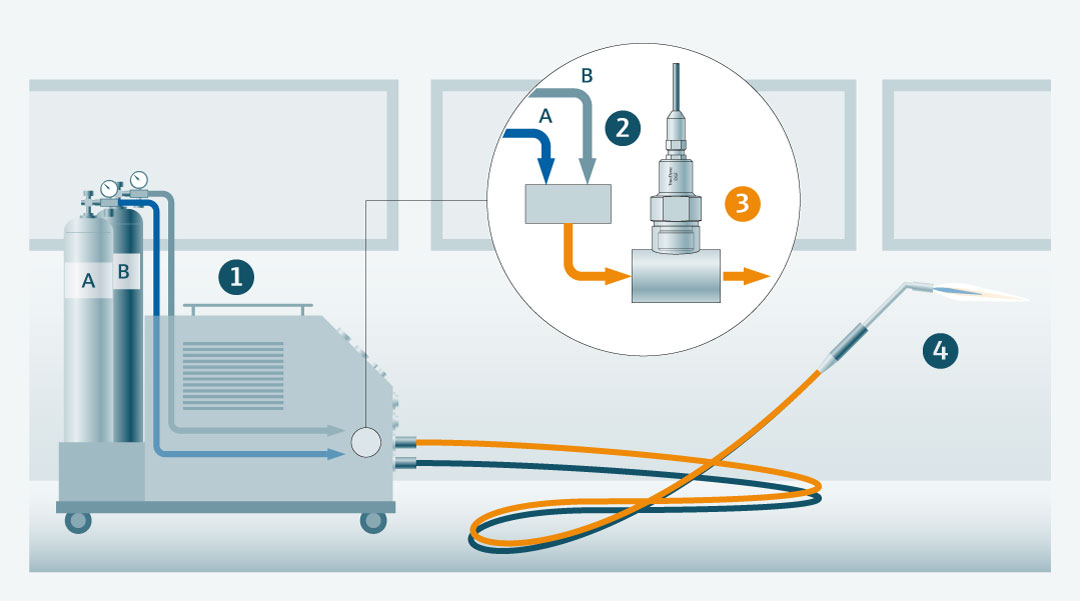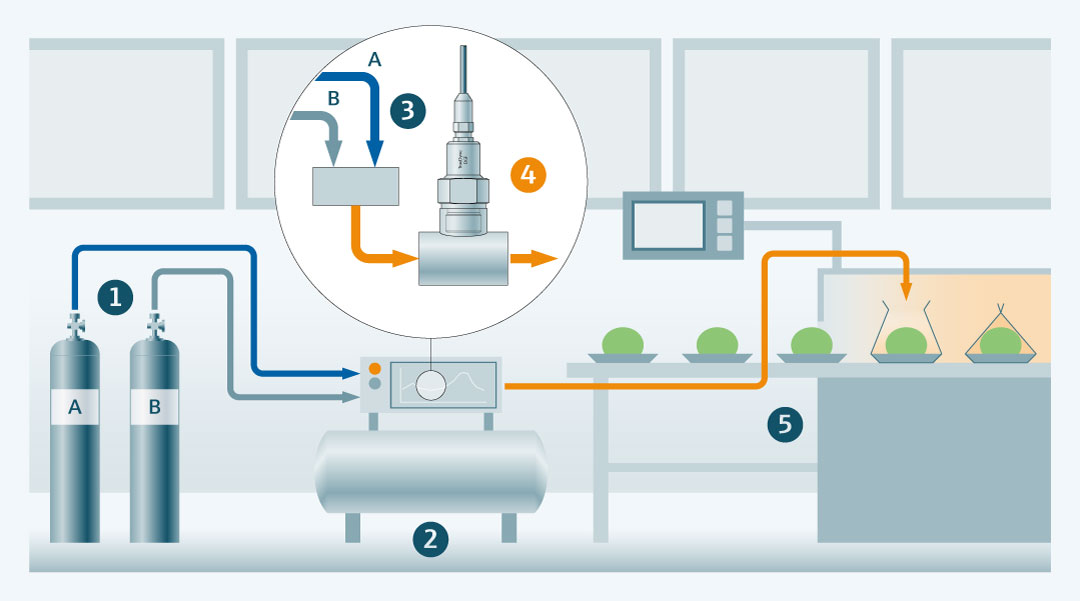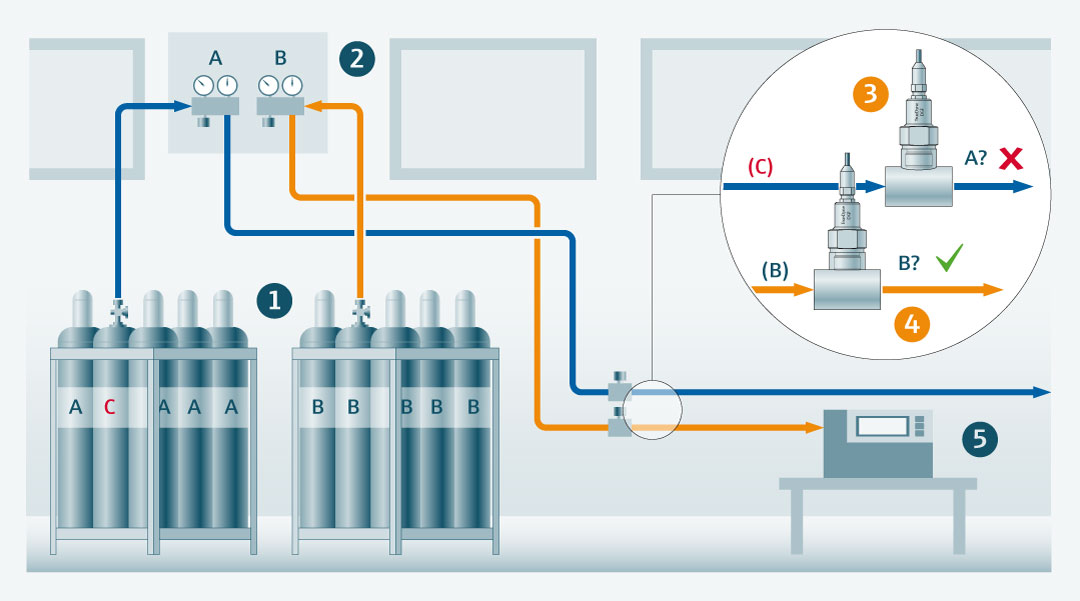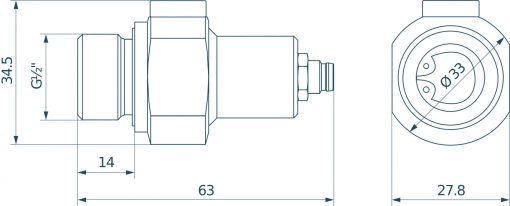Density sensor DGF-I1
Measure the density of a gas directly in the gas line or in the gas tank: This is made possible by the DGF-I1 density sensor from TrueDyne. At the heart of the sensor is a microelectromechanical system (MEMS) with an oscillator in the form of a tuning fork. For the measurement, the metal housing surrounding the MEMS is filled with the medium. The natural frequency of the oscillator varies depending on the density of the gas surrounding it. With an additional sensor element, the pressure and temperature of the medium are recorded directly at the measuring point.
The sensor is very compact with a diameter of 33 mm and a length of 63 mm and can be placed in even the smallest of spaces. It is screwed directly into the gas line or the gas tank with the integrated connection, and a filter protects against contamination. The measured values are transmitted to the higher-level system via an RS485 interface. The response time of 5 seconds enables density measurement directly in the process – the measurement does not have to be interrupted.
- DGF-I1 density sensor by TrueDyne measures gas density directly in gas lines or tanks using MEMS technology.
- Compact design, 33 mm diameter and 63 mm length, fits into tight spaces, screwable into gas lines with an integrated connection, and includes a contamination-filter.
- The sensor records natural frequency variations of its tuning fork oscillator to determine gas density; it also measures pressure and temperature.
- Data transmission to higher-level systems via RS485 interface with a rapid 5-second response time, allowing in-process density measurement.
- Monitoring welding gas mixtures for accurate welding quality by continuously checking the gas mixture's concentration, preventing defects.
- Ensuring the quality of gas mixtures for food packaging to extend shelf life and reduce waste, eliminating the need for spot checks.
- Monitoring clean gas usage in industrial processes to prevent mix-ups and guarantee gas quality in real-time, enhancing efficiency and avoiding costly errors.
Monitoring of welding gas mixtures
For a strong weld seam, the gases used must be correctly mixed. However, mechanical valves can move and leaks or mix-ups can lead to the mixing ratio no longer being correct. Up to now, it has only been possible to check the gas used by means of random sampling. With the TrueDyne sensor you can monitor the quality of your welding gas directly in the process. With the density data and with the help of tables and calculation algorithms, the concentration of the gases used can be precisely determined and reported to the customer.

1. Welding device.
2. Gas mixer which mixes the gases used for welding.
3. TrueDyne’s DGF-I1 density sensor measures the density of the gas mixture directly in the process. If this deviates from the nominal value, the process can be interrupted immediately.
4. Thanks to the ongoing quality control of the gas used, you can weld without rejects.
Monitoring of gas mixtures for food packages
Meat or fresh salads are packaged in a protective atmosphere so that they have a longer shelf life and do not turn brown. As standard, individual food bags are pierced after filling and the gas inside them is tested. If the result is inadequate, the entire production batch must be discarded. With the density sensor from TrueDyne, you can check the quality of the gas mixture in real time and directly in the packaging process – spot checks are no longer necessary and there is less waste.

1. Gas cylinders for the filling of food packages (mostly CO2 and N2).
2. Gas mixer.
3. The two gases, A and B, are mixed.
4. The DGF-I1 is integrated directly into the production process. The sensor measures the density of the gas mixture in real time and directly in the packaging process. 5. Food is packaged in a protective atmosphere. If the density measured by the sensor deviates from the nominal value, production can be interrupted.
Monitoring of clean gas
Gases are often colorless and odorless, they can be rather expensive, and damage can occur – previously, it was only possible to check whether the right gas was being taken out of storage or introduced into a process by means of random sampling. With the density sensor from TrueDyne, you can determine the density of a gas and thus the quality directly during operation. This prevents mix-ups and rejects.

1. Clean gas storage: A cylinder containing gas C has been incorrectly stored among cylinders containing gas A.
2. Pressure reducer.
3. The DGF-I1 is integrated into the filling system and measures the gas density in real time. If gas C is introduced, it detects the deviating density and stops the filling process.
4. If the DGF-I1 determines that the density of the gas is correct, the process continues.
5. The correct gas is used and the quality is guaranteed at all times.








